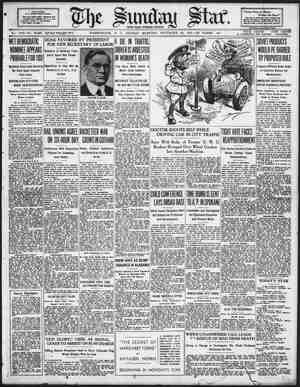Evening Star Newspaper, November 23, 1930, Page 91
You have reached the hourly page view limit. Unlock higher limit to our entire archive!
Subscribers enjoy higher page view limit, downloads, and exclusive features.
? - THE SUNDAY STAR, WASHINGTON, D. C, NOVEMBER 23, 1930, Comfleting What May Be His Last Voyage of Discovery to Mysterious Waters of the West Indies, Dr. Paul Bartsch Faces the Immense Task of Compiling His Amazing Facts on the Shell Fish Which He Has Been Studying for Years. BY ALMA CHESNUT. 11,18 sggsg E persistently by the scientist for many years. For him, today, there are no more riches in the thousand and one islands. He has ex- plored all but two or three very small ones and exhausted them all. OXES and crates containing more than & quarter of a million specimens crowded the Jose Enrique to the hatches. There were thoue sands of shells of rainbow tints and queer carved patterns; 1,000 bird skins, 4 large tore toise-shell turtles; 21 iquanas, rare lizardlike Dr. Paul Bartsch is an adventurer inte faraway places for the sake of science. (Photo by Bachrach.) ereatures, and 2 huge iguanas, 3'% feet long. The cruise was not without adventure. Ac- eompanied by four companions, including two Boy Seouts, Alva Nye and Ray Greenfleld of Washington; Howard Chittick, & pupil of Dr. Dr. Bartsch on « “deep sea ramble.” His greatest delight is to don & diving helmet and roam the sea floor. was that of the first secretary of the Smith- sonian Institution, a coincidence which, Dr. Bartsch pointed out to the youngsters, could onlybeeonnnwdumwsplcmmm.' Apparently it was. 'HE Jose Enrique carried the treasure seek- ers safely through the mase of islands south of Cuba, through the Cayman Islands, back to the west end of Cuba and the Isle of Pines, to ‘Battabano and Havana, then safely home. It weathered two hurricanes, including the one that destroyéd San Domingo. Dr. Bartsch’s attitude toward hurricanes, in which the captain of the ship surprisingly concurred, seems novel to landlubbers “We were locked up in Manzanillo Harbor during the first storm,” he stated, “for the authorities there had been notified of the hur- ricane by the Weather Bureau. I would have much preferrcd to have been on the high seas. It's safer. The second hurricane, the one that disappeared off Haiti, struck us when we were in the open sea. We got the tail end of it and were buffeted about rather severely, but I felt perfectly safe with thousands of fathoms of Most accidents, he explains, happen in har- bor, where ships are in danger of tossing about and being wrecked in collisions or against the shore. In the open sea, however, there is plenty of room and only the wind and the waves to battle, items which, in Dr. Bartsch’s opinion, more than counterbalance the fact that ship- wreck would find them a good, long swim from home! His attitude.toward the terror of the West Indies is pretty well indicated by a letter he wrote back to Washington just at the beginning of a recent cruise to the Antilles. “Everybody,” he reported, “is scared stiff about hurricanes, and most boats have been tucked carefully away the world. Adventures equally thrilling been met in the quiet sanctuary of his ‘Washington. (‘ The Guillermito (Little Willie), one of the small wooden craft in which Dr, Bartsch has ridden out the hurricanes of the West Indies, visited strange ports and sailed mysterious seas. By the time he had grown into a tafl lad he had established that occult sympathy with wild things that is the gift of the true naturalist. He could whistle the wild birds to him and make pets of foxes and wolves. At the time he completed his college coures he planned to be a botanist; he had already established a repu- tation as an authority on birds. The museum post offered a field altogether new and he soon became fascinated by the op- portunities it afforded for original work in his best-loved field. Soorlbehad-ecuredhlmnufllemdonot an outstanding authority on deep-sea life, A large measure of his success unquestionably is due to his originality of method and to his inventive genius. The deep-sea explorer en- counters difficult problems. The specimens he wants lie in a land untrod by human feet and there are two ways of getting them—going down after them or luring them to the surface. And however effective the latter method, it would ALWAYB an enth Bartsch early conceived the ideal of subsea photos and devised a cam ships cost shippers millions every % Dr.? Bartsch studied their habits end found a way to treat the wood so they refused to attack it. Above are several greatly enlarged drawings of types of ship worms. with a giass window in front of the lens and
